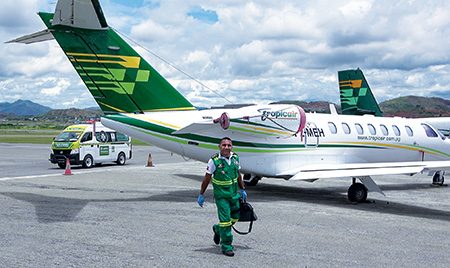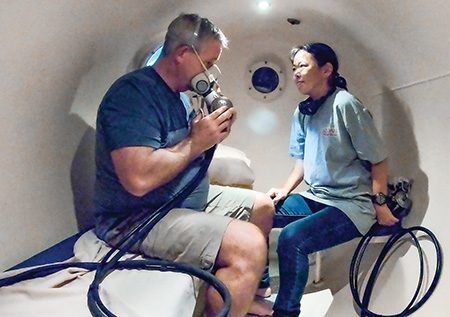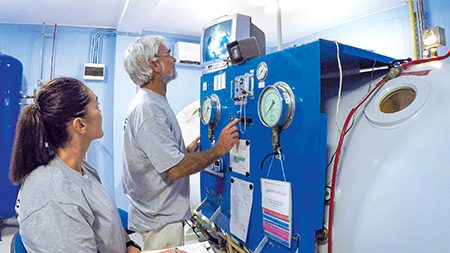I was diving with my wife, Kristy Hiltz, in remote Kimbe Bay, Papua New Guinea. We had taken all the necessary precautions and dived according to our computers. On what turned out to be our last dive, we sat on a rock ledge at 70 feet for 15 to 20 minutes and then made a slow ascent, completing a full safety stop. As I climbed onto the boat I knew something was wrong, but I thought I needed to drink water and wait for it to pass.
My vision became blurry, my stomach ached, and I felt dizzy and had trouble speaking clearly. Fortunately, my wife is a veterinarian with enough medical knowledge to discern that I had decompression sickness (DCS). She called for oxygen, and I lay down and focused on breathing it and trying not to pass out. We have always purchased DAN insurance but never expected we would need it. Suddenly, we were aware of how wise it was to have it.
Kristy and the tour director alerted the captain, and they discussed DAN and medical evacuation. I could hear phone calls and the words “serious” and “neurological symptoms.” The captain called the DAN emergency hotline, and the DAN medics planned the quickest path to the closest medical attention, which was in Port Moresby.
I tried breathing without oxygen but was immediately nauseated, dizzy, and confused. We were several hours from shore, and the experience was becoming very scary. We arrived late at night, so I stayed on the boat with oxygen until dawn, when an ambulance arrived for me. It was an old panel van with a worn mattress and tools in the back, but I was grateful for the drivers and the oxygen on the two-hour drive to the airport.
A jet was waiting for us on the runway, and Kristy and I were quickly in the air. On board I had nausea medication, IV fluids, more oxygen, and a comfortable cot, and the cabin was pressurized to mimic sea level. As we flew to Port Moresby, I knew what was happening, but the nausea and lightheadedness were distracting.
The hyperbaric chamber was at the airport, so the pilot pulled the jet close to the building, which was spotless and impressive inside. The team was ready and immediately put me in the chamber for a six-hour session. I soon felt my symptoms decreasing for the first time since the dive. I could finally think clearly and didn’t feel like throwing up.

After the chamber treatment I felt completely fine, and all my symptoms had disappeared. The physician restricted me from flying for four days, so I stayed in a nearby hotel to be monitored and assessed daily until I was able to go home. The doctor explained that DCS is dangerous and that I had experienced a close call with disaster. He also reminded me that flying home without completing proper hyperbaric treatment posed a life-threatening risk.
Our DAN dive accident insurance covered medical, hotel, and meal expenses — with the astronomical cost of the evacuation treatment I had received, I knew we were lucky to have it. A private jet or other evacuation from a remote area can cost more than $100,000 for the travel alone and require guaranteed payment before the evacuation. The cost might have caused us to delay treatment or make riskier decisions. But with DAN insurance, we could focus on what we needed instead of what we could afford.
I later saw a dive medicine cardiologist who thoroughly examined me and read my dive log and the physician’s reports. He said that I was extremely lucky to have survived and that vision loss is an indication of neurological danger. I was fortunate a chamber was available. The cardiologist also said that almost all divers who experience DCS rely on a dive computer without understanding its limitations.


Since then I have learned that I am among the 27 percent of people who have a patent foramen ovale — a hole between the right and left sides of the heart, which is linked to greater DCS risk. Divers are often unaware they have one. Relying heavily on my dive computer to calculate bottom time was risky, and although I was diving according to my training, a more conservative approach could help prevent further incidents.
I cannot imagine diving anywhere without DAN insurance coverage. We have started checking chamber locations when planning remote scuba trips. We appreciate that our coverage helps us in the case of an emergency and helps fund the chambers and teams that provide lifesaving care for divers worldwide.
When we needed help, DAN could not have been more accommodating. We will forever be grateful for everything they did for us.
© Alert Diver — Q1 2024